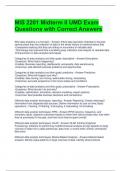MIS 2201 Midterm II UMD Exam
Questions with Correct Answers
Why data analytics is a hot topic - Answer--More data has been collected in the past
several years than the collection of data in the whole history of mankind before that
-Companies realizing that they are sitting on mountains of valuable data
-Technology has improved that is enabling easy collection and analysis of valuable data
-Enhancement in data analytics techniques
Categories of data analytics and their goals: descriptive - Answer-Descriptive:
-Questions: What has/is happening?
-Enables: Business reporting, dashboards, scorecards, data warehousing
-Outcomes: well-defined business problems and opportunities
Categories of data analytics and their goals: predictive - Answer-Predictive:
-Questions: What will happen and why?
-Enables: data mining, text mining, web/media mining, forecasting
-Outcomes: accurate projections of the future states and conditions
Categories of data analytics and their goals: prescriptive - Answer-Prescriptive:
-Questions: What should I do and why?
-Enables: optimization, simulation, decision modeling, expert systems
-Outcomes: best possible business decisions and transactions
Different data analytic techniques: reporting - Answer-Reporting: Create meaningful
information from disparate data sources; Deliver information to user on time; Basic
operations: 1.Sorting, 2.Filtering, 3.Grouping, 4.Calculating, 5.Formatting
Different data analytic techniques: RFM - Answer-RFM (recency, frequency, and
monetary value): segment customers based on when their last purchase was, how often
they've purchased in the past, and how much they've spent overall
Different data analytic techniques: OLAP - Answer-OLAP (Online Analytical
Processing): software for performing multidimensional analysis at high speeds on large
volumes of data from a data warehouse, data mart, or some other unified, centralized
data store
Different data analytic techniques: Market Basket Analysis - Answer-Market basket
analysis: Identify sales patterns in large volumes of data, Identify what products
, customers tend to buy together, Computes probabilities of purchases, Identify cross-
selling opportunities
Business applications for data analytics (fraud detection, market analysis, risk
management, logistics and operations) - Answer-fraud detection: uncovering patterns
consistent with criminal activity
market analysis: determining which products customers buy together, and how an
organization can use this information to cross-sell more products or services
risk management: The fundamental elements of risk management are the identification,
evaluation, and prioritization of risks, as well as steps taken to minimize the negative
aspects of risks, such as monitoring and controlling.
logistics and operations: refers to the process of moving finished goods, starting from
the manufacturer and moving to the end user
Definition of artificial intelligence - Answer-Computer software that can mimic or improve
upon functions that would otherwise require human intelligence.
Describe the goal of information systems security - Answer-1. Threat - person or
organization seeks to obtain data or other assets illegally, without owner's permission
and often without owner's knowledge
2. Vulnerability - opportunity for threats to gain access to individual or organizational
assets; for example, when you buy online, you provide your credit card data, and as
data is transmitted over Internet, it is vulnerable to threats
3. Safeguard - measure individuals or organizations take to block threat from obtaining
an asset; not always effective, some threats achieve their goal in spite of safeguards
4. Target - asset desired by threat
5. Risk - The probability of a threat exploiting a vulnerability and the resulting cost.
6. Exploit- Tools or techniques that take advantage of a vulnerability.
Explain the prevalence of the computer security problem - Answer--No one knows the
exact cost of computer crimes
-Data loss single most expensive consequence of computer crime
-80% of respondents believe data on mobile devices poses significant risks
Sources of threats to digital security - Answer-Unauthorized data disclosure
-Human error: procedural mistakes
-Computer crime: pretexting, phishing, spoofing, sniffing, hacking
Incorrect data modification
-Human error: procedural mistakes, incorrect procedures, ineffective accounting
-Computer crime: hacking




